Big Jake(1971), directed by George Sherman and starring John Wayne, Maureen O’Hara and Richard Boone, is a deliciously entertaining Western adventure that adds some modern elements to the standard ‘John Wayne Western’ template.
John Fain(Richard Boone): Who are you?
Jake(John Wayne): Jacob McCandles.
John Fain(Richard Boone): I thought you were dead.
Jake(John Wayne): Not hardly.
from Big Jake(1971)
You got to hand it to John ‘Duke’ Wayne; in 1971, at the age of 64 and in his fifth decade as an actor, he was once again voted the biggest box office star in America. Granted, that this was the last time he would manage this feat, but hell! which other movie star before or after him has managed to do this. This is apart from the fact that he was the star who has been in the top ten more than any other actor (25 years) in movie history. Clint Eastwood had an acting career well into his 80s, and had a big hit in Gran Torino when he was 78, but even his stardom pales in comparison to Big Duke’s star power and popularity, which he maintained till his end. He had, at the time, just recovered from cancer and was going on just one lung. Also, he had just won his one and only best actor Oscar for True Grit(1969) after so many years in the business. It was the back to back successes of True Grit, Chisum(1970) and Big Jake(1971) that once again elevated him to the top of the Box office. By the 1960s, the template for a ‘John Wayne Western’ had been perfectly set, True Grit was an anomaly in this, as Duke got to play a different kind of role in a different kind of a film, but once that was done, it was back to his bread and butter template for Duke. Of all the films he made in the post-True Grit phase, Big Jake is the most enjoyable, successful and John Waynish of them all; mind you, I’m not saying it was his best- that would be his final film, The Shootist, directed by the great Don Siegel, but that was more in the revisionist mode: an end-of-the-west Western that had John Wayne dying at the end(Shudder!). The Shootist was the kind of Western that Duke abhorred, and i think the only reason why he did that film was because he found a personal connection with the character he was playing. “Big Jake” epitomizes the kind of old-fashioned, traditional Western that made Duke the biggest movie star that ever was; a simple, morally simplistic, Good guys-bad guys Western adventure devoid of any kind of revisionism or psychological analysis (that was creeping into the Westerns of the time, and that would ultimately kill the genre.); with Duke playing a character specially tailored to suit his age, talents and his image: the titular ‘Big’ Jacob McCandless is a rich rancher, who turns his back on an affluent and domesticated life of a family patriarch, with a wife and three children, to lead the life of a loner- wandering the wilderness with his pet collie, who’s simply named “Dog”. Thus, the character combines the elements of the “loner\society outsider” character that he played in the early to mid stages of his career, as in Stagecoach, Hondo and The Searchers, and the self-made, affluent, family patriarchs he was playing in the latter part of his career- as in McLintock! and Chisum. In the film, Duke is surrounded by the members of his stock company: John Agar, Harry Carey, Jr., Glenn Corbett, Jim Davis, John Doucette, Gregg Palmer and Hank Worden; but the major highlight is his reteaming with his favorite co-star, Maureen O’Hara, with whom he made 5 films in total, and this would be their last film together. The film also had Duke’s son Patrick Wayne – who has done 10 films with Duke, and this will be the only time they’ll be playing father and son in a film- playing Jake’s middle son, James, and Christopher Mitchum (Robert Mitchum’s son) playing Jake’s youngest son Michael- which by the way is the name of Duke’s eldest son and the producer of this film. True to his age and real life stature, Duke is playing a grand father in the film who sets out to save his grandson, Little Jake, from the clutches of the villain, John Fain- played by Richard Boone, another one of Duke’s old pals. The role of Little Jake is played by Duke’s son, Ethan, who was born in 1962 and was named after his father’s legendary character in “The Searchers”. You see the ‘meta’ references piling up; and the casting of his son as grandson might be Duke’s way of saying that he maybe old enough to be a grandfather in real and reel life, but he’s still young, strong and resourceful enough to be a father. By this time in his career, it wasn’t just his real and real life image that has entwined together into an undistinguishable form, but also his and his family’s lifestyle; basically, much of his friends and family members were working on his films too. I am sure that at this stage in his life, when Duke was sitting down for dinner with his family & friends, they would be more than wondering whether they’re having dinner for real, or is there a director nearby who’s capturing all this on camera and would be screaming “Action” and “cut” anytime.
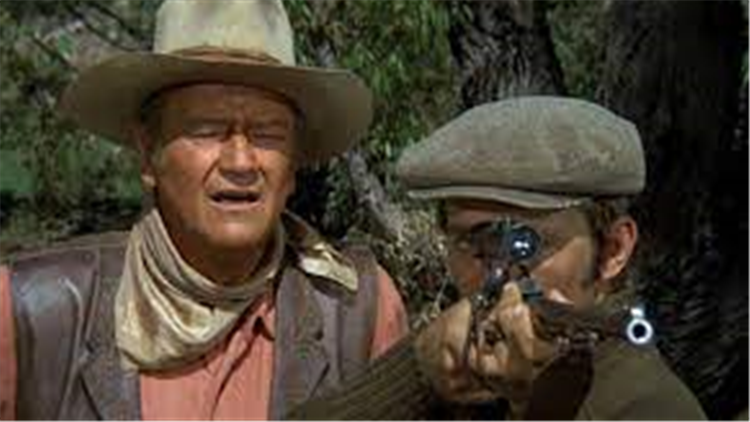
Though Duke was rigid about the kind of films he wanted to make, he was not above some flexibility in his template- if it’s not going to disturb the core structure of his film, and would make it more accessible to a contemporary audience. So “Big Jake” is the first of Duke’s Westerns to be set circa 1909, and features automobiles, semi-automatic pistols and telescopic rifles. It’s no doubt inspired by the success of such turn-of-the-century, ‘gringos south of the border‘ Westerns like “The Professionals”, “The Wild Bunch” and “Butch Cassidy and the Sundance Kid”. Also, this is one of the most violent of John Wayne movies (along with The Cowboys), which again is a reflection of the gritty, violent 1970s. Most of the violence happens in the first 15 minutes of the movie, where we see John Fain and his army wrecking havoc at the McCandles ranch. But before that we get an interesting prologue cum credit sequence in which the state of United States at the turn of the century is shown in the form of a ‘magic lantern’ show. Come to think of it, Many of the films in this phase of Duke’s career feature very interesting title sequences; i wrote at length about the opening sequence of Chisum (when i reviewed that movie) made up of paintings of a cattle drive, There is an interesting opening sequence in The Shootist as well. What the magic lantern show in this film basically does is to show the difference between America’s east and west; while culture, society and sports were thriving in the east, the west was still under the grip of outlaws and guns. One such outlaw is John Fain, who was a hero of US-Spanish war, but since has drifted into bank and train robberies and murder. We also get a brief description of each of his men: one is good with a machete, other is a gunfighter, etc.. Fain and his gang are coming from Mexico, and after crossing the Rio Grande they proceed to the McCandles ranch owned by Martha McCandles and her sons Jeff, Michael, and James. The Fain Gang consisting of The Fain Brothers, the Devries Brothers, John Goodfellow, Kid Duffy, Breed O’Brien, Pop Dawson, and Trooper, attacks the ranch and brutally slays men, women and children; seriously wounds Jeff and kidnaps Jeff’s son, Little Jake. Fain demands the delivery of a ransom of $1 million dollars for the boy’s release, which will be at a place designated by him, somewhere in Mexico. Martha arranges the money and has it locked up in a strongbox, and even as United States Army and the Texas Rangers are volunteering to deliver the ransom, Martha knows that she needs someone else for this job- her estranged husband, Jake, who had abandoned the family about a decade ago (9 years and 4 months to be exact) to wander the wilderness. As she puts it: “It is I think going to be a very harsh and unpleasant kind of business and will I think require an extremely harsh and unpleasant kind of man to see to it“.
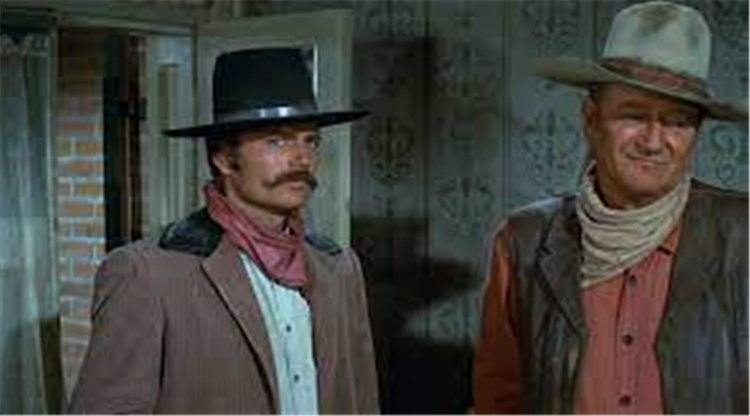
That’s all the buildup required for Duke’s introduction and, in the very next cut, we see the camera peering at the barrel of Jake’s Winchester Model 1892. Jake’s taking aim at a hanging party who are about to lynch a sheepherder. But contrary to what’s expected of Duke, he demurs, saying: “No sir. No sir, I ain’t. I ain’t butted into somebody else’s business since I was seventeen year old, at which time it almost got me killed“. But since it’s John Wayne we know he won’t let this injustice to occur in front of him, and soon enough, Jake spots the hanging party kicking the sheepherder’s boy. Now, Duke cannot abstain any further, but he finds a roundabout way to establish justice: he rides in, buys the sheepherder’s flock and tell him to deliver it personally to a particular ranch. Now he’s Jake’s employee, and Jake will protect him no matter what. Jake makes sure that the sheepherder is set free and warns the men that if anybody follows him, Jake will kill “every mother’s sons of them“. When the leader of lynch-party asks who he is, we get the conversation similar to the one that’s quoted at the beginning of the piece; is repeated throughout the film, and is a John Wayne character trademark- like “That’ll be the day
Who are you?
Jacob McCandles.
I thought you were dead.
Not hardly.
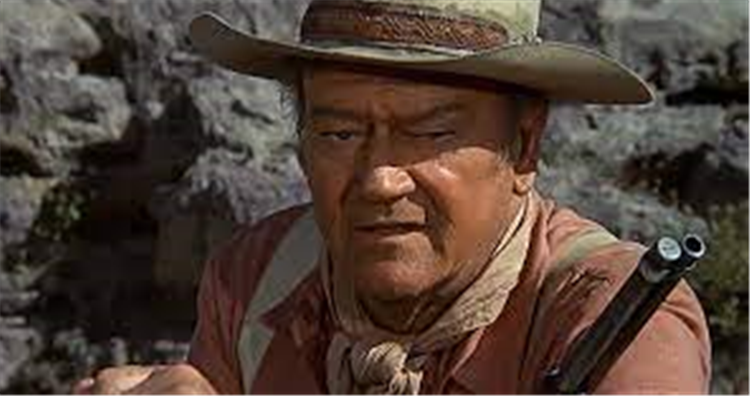
It also shows that Duke has a sense of humor about himself; a man who’s been in the business for more than 40 years, and who’s considered dead and buried by everybody, but he’s still there, alive and kicking. Soon, a letter arrives for Jake from his wife asking him to return home at once. Now, logical questions like how did Martha find Jake if the latter has been wandering the earth for so long, etc. are immaterial here: Westerns are basically myth and folklore, and a ‘John Wayne Western’ is a religion onto itself, with Duke as its reigning deity; suffice to say that “When emergency arises, the man appears.” Duke rides back home and is met by Martha at the station. The reunion scene between Duke (Jake) and Maureen(Martha) is as emotional a moment you can get; in all their previous films, Duke and Maureen have played bickering couples and this last one isn’t going to be different. Jake didn’t know until this time that he has a grandson; also, the meeting with his sons- who holds grudges against him for abandoning them – does not go smoothly. He had to physically rough James up to earn some respect, while the younger, Michael, who’s the more modern of the sons and ride around in motorcycles, and shoots with the latest automatic weapons is more forgiving and meets him warmly Martha’s got the money ready, which Jake plans to carry along into Mexico on mules and pack horses. But Martha also wants to send a group of Texas rangers on automobiles, as they may stand a better chance at getting back little Jake alive. Big Jake doesn’t like it, but goes along anyway.
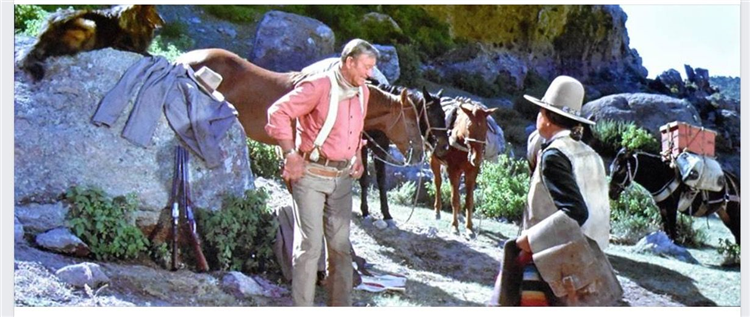
Thus, they set forth on their journey: the ancient warrior ,Big Jake, on his horse, accompanied by his pet collie and dragging the pack horses, while the rest, including his sons on modern modes of transportation like REO Runabouts and motorbikes. The journey more than brings to mind John Ford’s “The Searchers”: where too Duke set out to rescue his blood relation from kidnappers, except , the change in times are well reflected in the movie, not only in the ‘modernity’ seen all around, but also the change in the race of the kidnappers; here it’s the whites and not ‘injuns’; by this times the ‘injun’ had become Duke’s best friend, and this film, Jake has an Apache friend, Sam Sharpnose (Bruce Cabot), who joins up with Jake on the mission. The Rangers believe that they can outrun Fain and gang and set up an ambush, but it’s Fain who sets up the ambush first; in which the automobiles are destroyed, many are killed, and the rest of the rangers are left stranded in the middle of the wilderness. Leaving the rangers behind, Jake, now joined by his sons on horseback, continues on in his journey. The long journey becomes a period of healing of relationships, as father and sons get to know each other better, which leads to a lot of funny situations . Soon, they realize that they are being followed by bandits who intend to steal the money. To get them of their backs, they create an elaborate ruse- too elaborate, I’m afraid that it would make for one long episode of a TV series, and it doesn’t add much to the film, except for the mandatory bar room brawl in a John Wayne Western. Once the bandits are off their backs, it’s time for Jake and sons to fight it out among themselves, after it’s revealed that the cash box contains paper clippings instead of money. The sons suspect the father of stealing the money, but Jake assures them that it was his and Martha’s idea right from the beginning that they’re going to get the boy back without paying anything to the kidnappers.
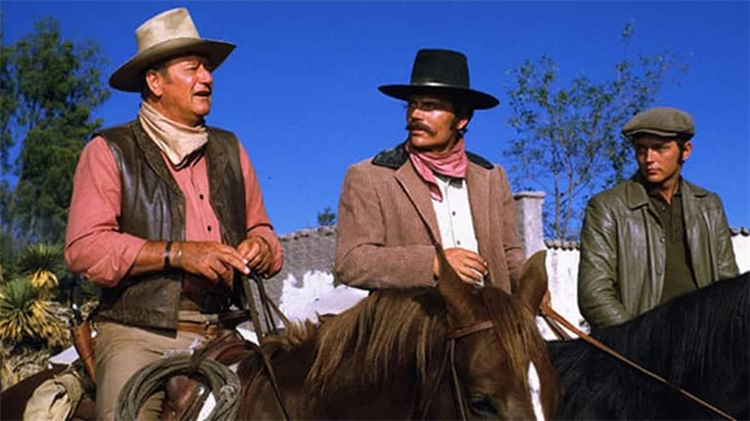
Now comes the time for the final showdown, when Jake and his boys has to deliver the money to Fain. Jake carefully plans their moves, as to where each one should be and what they must be doing, especially since Little Jake’s life is going to be in Fain’s hands. And as in all ‘John Wayne Western’ climaxes, Duke and the villain, Fain, talks it out for a while, and then the shooting starts. The climax is long, but it’s not as grand or epic as the climaxes of True Grit or Chisum, but it’s no less mythic and theatrical: it takes places at night, in darkness, in the premises of a dilapidated fort holding a church. There’s thunder and lightning, with the sounds of church bells creating an additional effect, and John Goodfellow, Fain’s machete wielding henchman turns out to be devil incarnate himself, slaughtering everything in his sight, as Jake’s pet dog and his Apache friend falls victim to his machete. But as expected, Jake manages to triumph the odds with more than little help from his sons, and the grandfather and his grandson are together for the first time in their lives as they prepare to head back home.
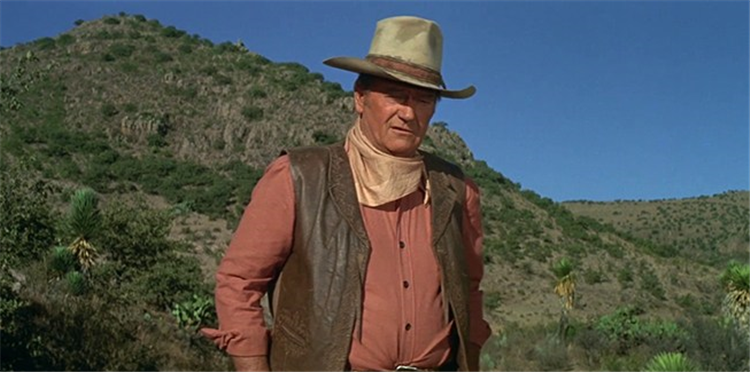
The film is written by the “Fink” husband and wife team of Harry Julian and Rita, who also wrote “Dirty Harry” the same year; and that might account for much of the ‘modernity’, the showcasing of cutting edge weaponry, and excessive violence in the film- apart from the opening, the climax is also an extremely bloody affair. Their participation may also account for the highly quotable dialogue in the film, though Duke’s films have never been short of them. There are some similarities between this film and Dirty Harry, like the film beginning with the main villain going on a killing spree, then kidnapping of the child, and the kidnapper giving the guy delivering the ransom a merry go around. The film benefits immensely from having Richard Boone as the bad guy; He makes a powerful villain for Duke to play against. He portrays John Fain as someone polished and cool; who’s not that that interested in killing people, but he would if they crossed his path. It’s a pity that he and Duke has only two scenes together, but the climax has them playing against each other at their best. There’s a moment where Fain feels Jake is about to pull a fast one on him, and he coldly warns him that if anything goes wrong, he’s going to kill little Jake. Later, when Jake gets the upper hand in their battle of wits and gets Fain under his gun, he throws Fain’s words right back at him: “now you understand. Anything goes wrong, anything at all… your fault, my fault, nobody’s fault… it won’t matter – I’m gonna blow your head off. No matter what else happens, no matter who gets killed I’m gonna blow your head off“. It’s a great line, and it’s very interesting to hear both these actors delivering them in their individual styles. This is again repeated in Dirty Harry, with the “Do you feel lucky” monologue delivered twice in the film. One thing that does not work so well in the film is the banter between Jake and his sons, because neither Duke son, Patrick, nor Mitchum’s son, Chris, are very good, and just cant match up to Duke in their scenes together. Also, though Duke and Maureen still work great together, they too share only few scenes, and that too only in the beginning. I felt that there should have been some scenes at the end as well, when Jake and the boys return home.
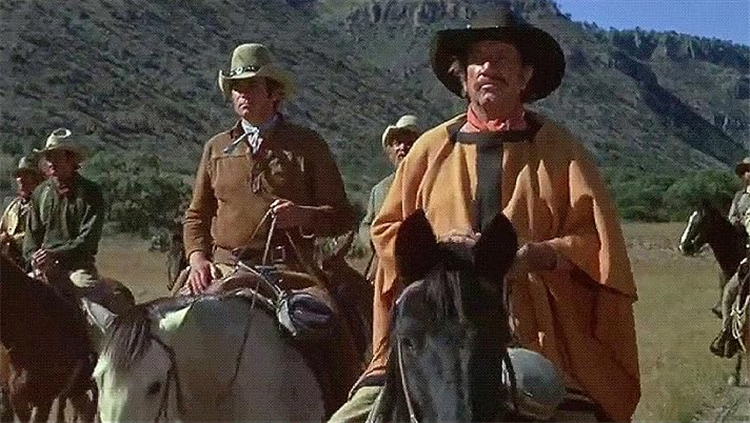
The film is directed by George Sherman, who directed Duke in Republic studios’ Western programmers in the 1930s. This will be Sherman’s last film, and he was very ill at the time of making this film. So, much of the film was directed by John Wayne himself. In this part of his career, Duke was working with directors who were either sick- Michael Curtiz in The Commencharos; or nearing retirement- Howard Hawks in Rio Lobo; or his stock company director, Andrew V. McLaglen. Whatever the case, it was Duke who was calling the shots on these pictures. He knew what worked for him, and what audiences expected from him more than anybody, and Big Jake, for me, is perhaps the last great ‘john Wayne Western’. It was his last big commercial hit anyway; and even though Cahill, The Train Robbers and Rooster Cogburn are all entertaining in their own way, they just don’t get the mix of john Wayne persona married to a interesting character and a very entertaining yarn as well as this film does. Big Jake finds Duke at his most relaxed and rapscallion. He still dominates the screen like no other star, and his delivery of his trademark punchlines still carry that extra zing. Add to that a rousing Elmer Bernstein score, which has themes remixed from his legendary, The Magnificent Seven, composition; and the great cinematographer (and John Ford and John Wayne regular) William H. Clothier delivering the fantastic technicolor widescreen visuals of the Mexican landscape, and Big Jake becomes one great John Wayne Western adventure.
